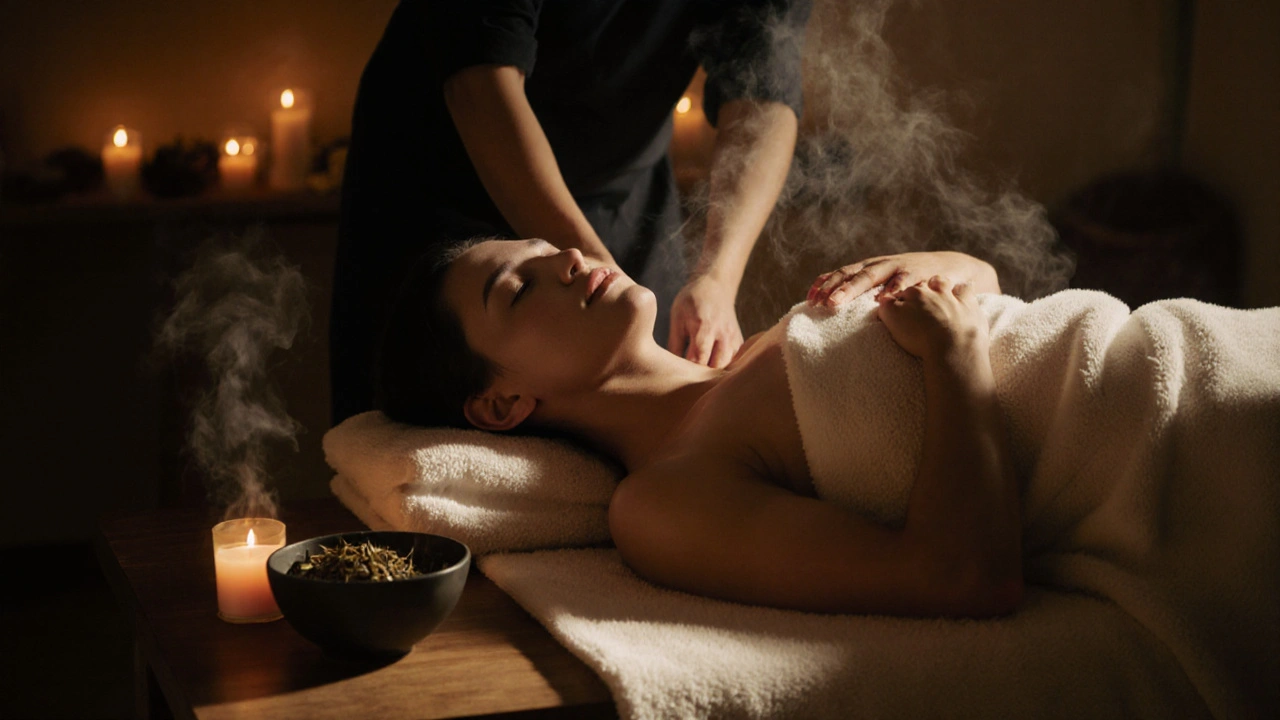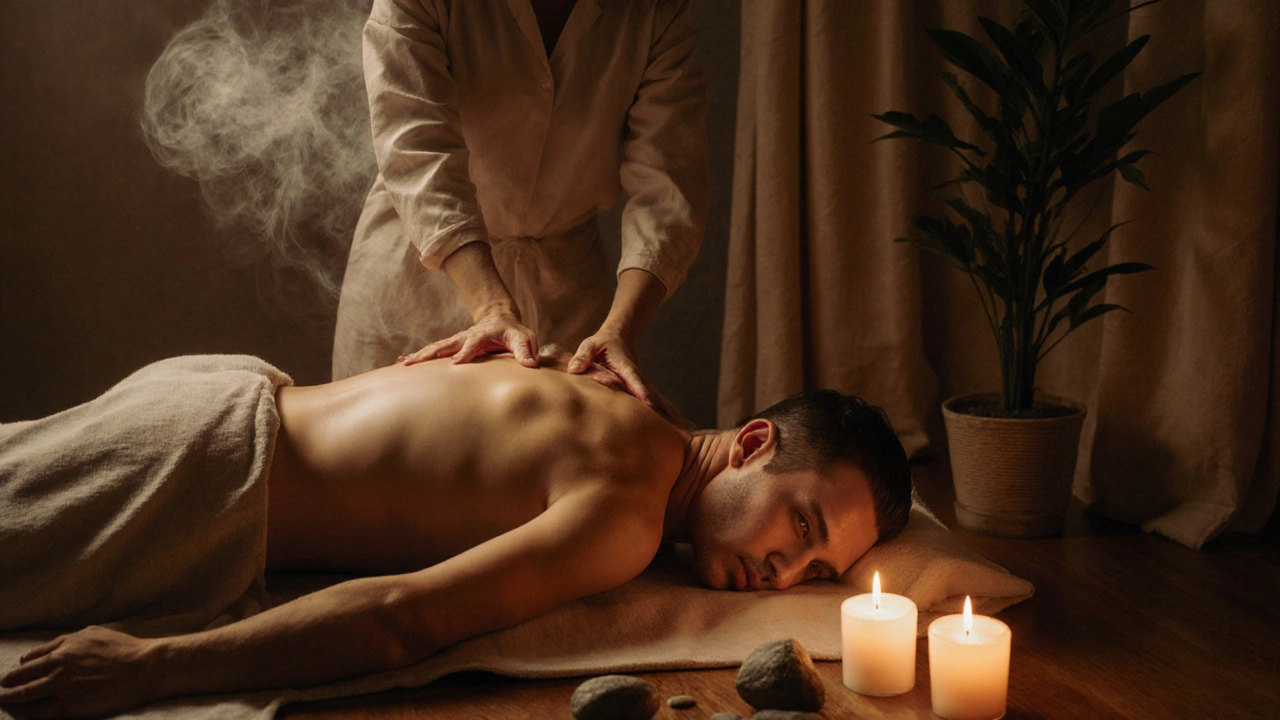The Role of Tantric Massage in Personal Growth and Development

You’ve probably heard whispers about tantric massage-some call it spiritual, others say it’s just another kind of touch. But if you’ve ever felt stuck, emotionally drained, or disconnected from your own body, you might be wondering: can tantric massage really help you grow as a person? The answer isn’t yes or no. It’s deeper than that.
What Tantric Massage Actually Is (And What It’s Not)
Tantric massage isn’t about sex. It’s not a romantic date, and it doesn’t end with an orgasm. That’s the biggest myth. Real tantric massage is a slow, intentional practice rooted in ancient Indian and Tibetan traditions that use breath, presence, and touch to awaken energy-not pleasure.
Think of it like this: your body is a network of pathways. When you’re stressed, anxious, or numbed out from life, those pathways get clogged. Tantric massage doesn’t just rub your muscles-it helps clear those blockages. A trained practitioner uses gentle, sustained touch, often starting with the feet or back, moving slowly upward. There’s no rush. No agenda. Just presence.
It’s not magic. It’s neuroscience. Studies show that slow, non-sexual touch activates the vagus nerve, which lowers cortisol, slows heart rate, and signals safety to your brain. That’s why people often cry during their first session-not because something’s wrong, but because their body finally feels safe enough to release what it’s been holding onto for years.
How Tantric Massage Supports Personal Growth
Personal growth sounds fluffy until you’re sitting in your car after a 12-hour workday, staring at the steering wheel, wondering why you feel so empty. That’s when tantric massage starts working.
Here’s how it helps:
- You reconnect with your body. Most of us live in our heads. We think too much, feel too little. Tantric massage brings you back into your skin. You start noticing sensations you’ve ignored-tightness in your jaw, heat in your palms, a flutter in your chest.
- You learn to sit with discomfort. A lot of what comes up during a session isn’t pleasant. Old shame. Unresolved grief. Fear of being seen. The practice teaches you to breathe through it instead of running.
- You break patterns of emotional avoidance. If you’ve ever said, “I’m fine,” when you weren’t, tantric massage gives you a safe space to stop lying to yourself.
- Your relationships improve. When you stop numbing out, you start showing up. You listen better. You set boundaries. You stop seeking validation from others because you’re finally tuning into your own needs.
One client, a 42-year-old teacher from Berlin, told me after five sessions: “I cried for 20 minutes the first time. I hadn’t cried since my dad died. But after that, I started telling my kids I loved them. Not because I was told to. Because I finally felt it.”
What Happens During a Session
There’s no script. Every session is different. But here’s what you can generally expect:
- You’ll be asked to shower and wear loose clothing-or nothing at all, depending on your comfort level.
- You’ll lie on a warmed table. The room is quiet, dim, with soft music or silence.
- The practitioner begins with slow, grounding strokes-often on your feet or back. No oil at first. Just touch.
- As you relax, they may move to your belly, chest, or thighs. The touch stays light, deliberate. No pressure, no teasing.
- If you feel arousal, that’s normal. The practitioner won’t react. They’ll keep breathing. They’ll keep you grounded.
- At the end, you’ll be wrapped in a warm towel. You might feel dizzy. Or calm. Or strangely quiet.
There’s no talking during the session unless you initiate it. No eye contact unless you want it. The space is yours.

Who Should Try Tantric Massage
This isn’t for everyone. But if you’re feeling any of these, it might be exactly what you need:
- You’re emotionally numb or disconnected from your body
- You struggle with intimacy or fear being touched
- You’ve been through trauma and avoid physical closeness
- You’re stuck in a cycle of anxiety or depression
- You want to feel more alive-but don’t know how
It’s not therapy, but it often unlocks what therapy can’t reach. If you’ve tried talk therapy and still feel like something’s missing, tantric massage might be the missing piece.
What to Look for in a Practitioner
Not everyone who calls themselves a tantric massage therapist knows what they’re doing. Here’s how to find someone real:
- They don’t promise sexual outcomes. Real practitioners never mention orgasms, pleasure, or erotic results.
- They have training. Look for certifications from schools like the Tantric Institute of Amsterdam, the School of Sacred Touch, or the International Tantra Network.
- They have boundaries. You’ll be asked to sign a consent form. They’ll explain the process. No pressure.
- They’re not flashy. No Instagram models in silk robes. Real practitioners often work out of quiet studios, not luxury spas.
Ask: “What’s your training background?” and “How do you handle emotional releases?” If they hesitate or give vague answers, walk away.

Tantric Massage vs. Other Massage Types
It’s easy to confuse tantric massage with other types. Here’s how it’s different:
| Aspect | Tantric Massage | Swedish Massage | Sexualized Massage |
|---|---|---|---|
| Primary Goal | Energy awareness, emotional release, presence | Relaxation, muscle relief | Pleasure, sexual release |
| Touch Style | Slow, intentional, non-goal-oriented | Effleurage, kneading, rhythmic | Provocative, suggestive, goal-driven |
| Emotional Response | Crying, quietness, clarity | Relaxation, drowsiness | Euphoria, guilt, emptiness |
| Training Required | Extensive (mindfulness, trauma-informed touch) | Basic anatomy, 100+ hours | None (often illegal) |
| After-Effect | Long-term emotional shift | Short-term relaxation | Temporary high, then shame |
The difference isn’t just technique-it’s intention. Tantric massage isn’t about what happens to your body. It’s about what happens inside you.
What to Do After Your Session
Don’t rush out. Don’t check your phone. Don’t go straight to work.
After a session, your nervous system is in a rare state of openness. You’re more sensitive. More aware. This is when integration matters.
- Drink water. Your body is releasing stored tension.
- Write in a journal. What came up? What did you feel? Don’t judge it. Just observe.
- Go for a quiet walk. Let your body settle.
- Avoid alcohol, screens, or social media for at least 4 hours.
- Don’t force insight. The real shifts often show up days later.
One woman told me she started dreaming about her childhood after her third session. She didn’t understand why-until she realized she hadn’t thought about her mom in 15 years. That’s the quiet power of this work.
Is Tantric Massage Right for You?
If you’re looking for a quick fix, skip it. If you want to feel better in 30 minutes, go get a Swedish massage.
But if you’re ready to stop running from yourself-if you’re tired of feeling like something’s missing, even when everything looks fine on the outside-then tantric massage might be the most honest step you’ve taken in years.
It won’t fix your job. It won’t fix your relationship. But it will help you stop running from the part of you that’s been waiting to be seen.
Is tantric massage the same as erotic massage?
No. Erotic massage is designed to lead to sexual release. Tantric massage is designed to help you become more present, more aware, and more connected to your own energy. While arousal can happen, it’s not the goal-and a professional practitioner will never push or encourage it. The focus is on emotional and energetic release, not physical climax.
Can I do tantric massage on my own?
You can practice self-tantra-slow, mindful touch, breathwork, and body awareness-but it’s not the same as a guided session. A trained practitioner holds space for you in a way you can’t hold for yourself. When you’re overwhelmed, numb, or stuck, your own mind will find ways to avoid the pain. A skilled guide helps you go deeper than you could alone.
How many sessions do I need to feel a difference?
Some people feel shifts after one session-especially if they’ve been emotionally shut down for a long time. But real, lasting change usually takes 3-5 sessions. Think of it like therapy: one talk won’t rewrite your patterns, but consistent work will. The more you show up, the more your body learns it’s safe to let go.
Is tantric massage only for people who’ve experienced trauma?
No. While it’s powerful for trauma survivors, it’s also for anyone who feels disconnected-from their body, their emotions, or their sense of self. Many people come because they’re high-achievers who’ve lost touch with their inner world. They’re not broken. They’re just tired of pretending they’re fine.
Are there any risks?
The biggest risk is working with someone untrained. Always verify credentials and boundaries. A legitimate practitioner will never pressure you, touch you without consent, or make sexual advances. If something feels off, stop. Trust your gut. Emotional release can be intense, but it’s safe when guided properly. If you have severe mental health conditions, talk to your therapist first.



Kristen Sardis Barry
November 3, 2025 AT 07:15Kristi Bangs
November 3, 2025 AT 08:14Bryan Peele
November 4, 2025 AT 10:59Paige Vejnar
November 5, 2025 AT 15:43Vanness Latricia
November 7, 2025 AT 07:37Debbie Nehikhuere
November 9, 2025 AT 00:55Michael Soaries
November 10, 2025 AT 13:51